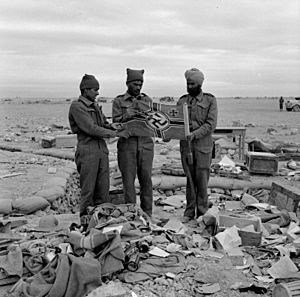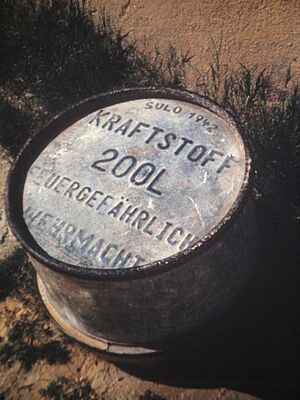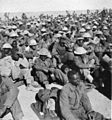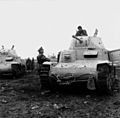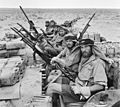North African campaign facts for kids
Quick facts for kids North African campaign |
|||||||||
|---|---|---|---|---|---|---|---|---|---|
| Part of World War II | |||||||||
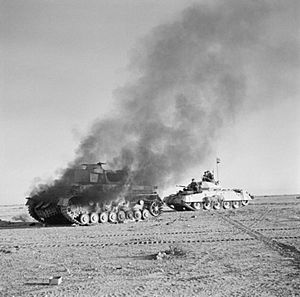 A British Crusader tank passes a destroyed German Panzer IV tank during Operation Crusader, November 1941 |
|||||||||
|
|||||||||
| Belligerents | |||||||||
|
|
||||||||
| Commanders and leaders | |||||||||
|
|||||||||
| Casualties and losses | |||||||||
The North African campaign was a major part of World War II. It took place in North Africa from June 10, 1940, to May 13, 1943. This campaign included battles in the deserts of Libya and Egypt. It also involved fighting in Morocco, Algeria, and Tunisia.
The main groups fighting were the Allies and the Axis Powers. The Allied side was mostly made up of forces from the British Commonwealth. Soldiers from countries occupied by Germany also joined. The United States officially entered the war in December 1941. They started helping in North Africa in May 1942.
The fighting began when Italy declared war on June 10, 1940. British troops quickly moved into Libya. They captured an Italian fort. Italy then attacked Egypt, taking Sidi Barrani. But the British and Commonwealth forces soon took it back in an operation called Operation Compass. During this time, the Italian 10th Army was badly beaten. Germany sent its Afrika Korps to help. This force was led by Erwin Rommel, who became known as "The Desert Fox."
Many battles followed for control of Libya and parts of Egypt. A key moment was the Second Battle of El Alamein in October 1942. British Commonwealth forces, led by Bernard Montgomery, defeated Rommel's army. The Axis forces were pushed back into Tunisia. In November 1942, American and British troops landed in North-West Africa (Operation Torch). After some fighting, they surrounded the German and Italian troops in northern Tunisia. The Axis forces surrendered in May 1943.
This Allied victory in North Africa led to the invasion of Italy. This eventually caused the fall of Italy's fascist government.
Contents
Desert War: Western Desert Campaign
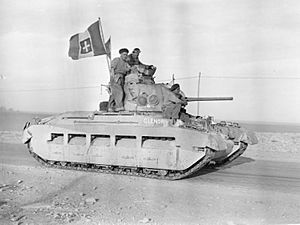
In May 1940, Germany started the Battle of France. France surrendered six weeks later. On June 10, Italy joined Germany and declared war on France and the United Kingdom. British forces in Egypt were told to get ready to defend. They also started raiding Italian positions in Libya.
After France was defeated, Italian troops moved to reinforce their army in Libya. British forces were getting weaker. So, General Archibald Wavell stopped the raids. He placed a small force to guard the Egyptian border.
Italian leader Benito Mussolini ordered his army to invade Egypt. The Italians were slow because they lacked transport and training. On September 8, they were ordered to attack the next day. Their plan was to move along the coast.
To stop them, Wavell ordered his small forces to bother the Italians. They slowly fell back towards Mersa Matruh. The main British army was there. The British 7th Armoured Division was ready to attack the Italian side.
By September 16, the Italian army reached Maktila. This was about 80 miles (130 km) west of Mersa Matruh. They stopped because they had problems getting supplies. Mussolini wanted them to keep going. But General Rodolfo Graziani ordered his men to dig in around Sidi Barrani. They set up fortified camps.
The British planned a quick attack called Operation Compass. They would hit these camps one by one. On December 9, the British Commonwealth force of 36,000 men attacked the Italian army. The Allies succeeded and chased the retreating Italians. In January, they captured the port of Bardia. Soon after, they took the strong port of Tobruk.
About 40,000 Italians were captured in these ports. The rest of the Italian army retreated to El Agheila. British General Richard O'Connor sent the 7th Armoured Division across the desert. They reached Beda Fomm before the Italians. This cut off their escape. The Italians tried to break through at the Battle of Beda Fomm but failed. The remaining Italian army surrendered. In just over ten weeks, the Allies destroyed the Italian Tenth Army. They took 130,000 prisoners.
Mussolini asked Germany for help. Italy also sent more motorized and armored forces to North Africa. Germany quickly sent a force called the Afrika Korps. It arrived in Tripoli in February. This force was led by Erwin Rommel. His job was to help the Italians and stop the Allies. However, Germany sent only a small number of tanks and troops. Most of the new forces were Italian.
The Allied forces, now called XIII Corps, took a defensive position. Over the next months, they got stronger. But then, many of their experienced troops were sent to Greece. They were replaced by new, less experienced soldiers.
Rommel was told to just hold the line. But in March, his armored units started a full attack from El Agheila. In March and April, Allied forces were pushed back. Many Allied generals were captured. The Australian 9th Infantry Division fell back to the fortress of Tobruk. The remaining British and Commonwealth forces went further east to the Libyan-Egyptian border.
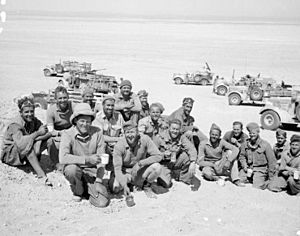
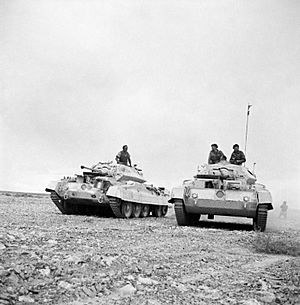
Tobruk was surrounded by the main Italian-German force. But its defenders still got supplies by sea from the Royal Navy. Rommel's forces were not strong enough to take the fortress. This caused supply problems for his troops. His front lines were far from Tripoli, and supplies had to go around Tobruk. Also, the British forces in Tobruk were always a threat. Without taking Tobruk, it was hard for the Axis to advance into Egypt.
The Allies tried a small attack called Operation Brevity. They wanted to push Axis forces off key passes at the border. They had some early success but could not hold the positions. They then launched a bigger attack, Operation Battleaxe, to relieve Tobruk. But this operation also failed.
After this failure, General Archibald Wavell was replaced by General Claude Auchinleck. The British forces were strengthened and became the Eighth Army. This army included troops from Britain, Australia, India, New Zealand, South Africa, and Free French forces.
The Eighth Army launched a new attack, Operation Crusader, in November. After a tough battle, the forces defending Tobruk were relieved. The Axis forces had to retreat. By January 1942, the front line was back at El Agheila.
The Axis forces got more supplies and attacked again. They defeated the Allies in the Battle of Gazala in June. They also captured Tobruk. The Axis pushed the Eighth Army back to the Egyptian border. But their advance stopped in July, only about 90 miles (145 km) from Alexandria, at the First Battle of El Alamein.
General Auchinleck stopped Rommel's advance at El Alamein. But he was replaced by General Harold Alexander. Lieutenant-General Bernard Montgomery took command of the Eighth Army.
In late October, the Eighth Army launched a huge attack. They decisively defeated the Italian-German army in the Second Battle of El Alamein. They pushed the Axis forces west and captured Tripoli in January 1943. By February, the Eighth Army was facing the Axis army near the Mareth Line in Tunisia. This was the final stage of the war in North Africa.
Operation Torch: Allied Landings
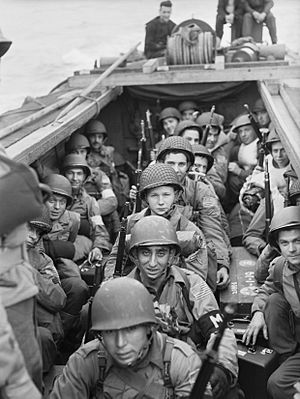
Operation Torch was an Allied plan in November 1942. It helped the British win in North Africa. It also allowed American forces to fight Germany on a smaller scale. This operation also helped the Soviet Union. The Soviet leader, Joseph Stalin, wanted the Allies to open a second front. This would make Germany move troops away from the Eastern Front. Many German transport planes needed for the battle at Stalingrad were instead used to supply Axis forces in North Africa.
Some U.S. commanders did not want to land in North-West Africa. They wanted to invade northern Europe instead. But Prime Minister Winston Churchill pushed for the North Africa landing. President Franklin D. Roosevelt ordered that Operation Torch happen as soon as possible. This was one of only two direct orders he gave to military commanders during the war.
The landings began on November 8 and ended on November 16. Allied forces (American and British) landed in French North Africa. This area was controlled by Vichy France. The Allies thought there would be little fighting. However, Vichy French forces fought hard in Oran and Morocco. But in Algiers, French resistance fighters took control. They arrested Vichy commanders before the landings. So, the Allies faced no real resistance there. Algiers was captured on the first day.
After a few days, Vichy Admiral François Darlan and General Alphonse Juin ordered their forces to stop fighting. They joined the Allies. During Operation Torch, Americans also fought Vichy French and German navy ships in the Naval Battle of Casablanca. The Americans won this battle.
The Allied landings caused the Axis to occupy Vichy France. The Italians also captured the French fleet at Toulon. But most of the French fleet had been sunk by its own crews to prevent the Axis from using it. The Vichy army in North Africa then joined the Allies.
Tunisian Campaign: The Final Push
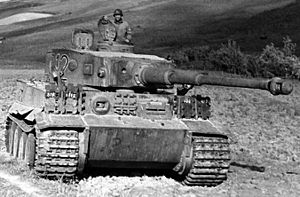
After the Operation Torch landings in November 1942, Germany and Italy sent many troops to Tunisia. They wanted to fill the gap left by the Vichy French troops. The Allies decided not to rush into Tunisia. They were still dealing with the Vichy authorities. Many Allied soldiers were busy guarding areas because they were unsure about the Vichy forces.
By mid-November, the Allies could move into Tunisia. But they only had one division at a time. By early December, the British First Army had British, American, and French units. But by then, Germany and Italy had sent six divisions from Europe. Also, Allied airfields were far from the front line. This gave the Axis clear control of the sky. The Allies were stopped and pushed back. They had gotten within 30 km (19 mi) of Tunis.
In early December, the Allies realized they could not capture Tunis and Bizerta quickly. Axis air attacks made it hard for the British. However, the Allies had secured the island of Malta. This helped them with future air operations. On land, British and American forces held their positions. On December 4, 1942, Allied reports said fighting was ongoing in the Tebourba area. The Axis tried a second attack there, but the Allies stopped them. The Axis lost many weapons.
During the winter, there was a quiet period. Both sides built up their forces. By the new year, the British First Army had British, US, and French corps. In February, Rommel and von Arnim had some success against the less experienced French and US troops. They defeated the US II Corps at the Battle of Kasserine Pass.
By early March, the British Eighth Army had reached the Tunisian border. Rommel and von Arnim were caught between two Allied armies. They were outnumbered and outgunned. Rommel went back to Germany due to health issues. Italian General Messe took over.
The British Eighth Army got around the Axis defenses on the Mareth Line in late March. The First Army in central Tunisia launched its main attack in mid-April. They squeezed the Axis forces until they surrendered in Africa. The Axis forces gave up on May 13, 1943. Over 275,000 Axis soldiers became prisoners of war. This huge loss of experienced troops greatly weakened the Axis powers. Some Axis troops did escape Tunisia. This defeat meant all Italian colonies in Africa were captured.
Aftermath
After the Allies won the North African campaign, the way was open for the Italian campaign. The invasion of Sicily happened two months later. Nearly 400,000 Axis and Allied soldiers were lost, injured, or died from disease by the end of the North African campaign.
Images for kids
-
Czechoslovak 11th Infantry Battalion defending Tobruk.
-
Erwin Rommel with Italian governor of Libya, General Italo Gariboldi in Tripoli, February 1941.
-
British colonial troops captured by Italian and German forces in 1941.
-
British SAS patrol in armed jeeps.
See also
 In Spanish: Campaña en África del Norte para niños
In Spanish: Campaña en África del Norte para niños
- North African campaign timeline
- Timelines of World War II by year: 1940 / 1941 / 1942 / 1943



